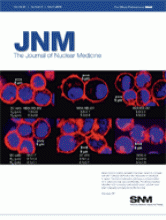REPLY: It is our pleasure to answer the letter of Dr. Jadvar about our paper (1).
The diagnostic flow chart of patients with biochemical relapse after radical prostatectomy has yet to be defined with regard to either the most appropriate test to perform after a prostate-specific antigen (PSA) increase or the optimal timing for performing the test. It is probable that this lack is due to the fact that conventional imaging methods (CT, MRI, bone scanning, transrectal ultrasonography) have shown limited value in restaging of the disease, particularly when the PSA values are low (2). Furthermore, the optimal timing for performing imaging tests after biochemical failure is not well established yet because a balance has to be struck between the clinical need for early detection of relapse and the need to perform the tests when PSA values are high and, consequently, there is a higher probability of detecting relapse (3).
To find a possible solution to this problem, we have tried to clarify at least one aspect: the relationship between PSA values and PSA kinetics on the one hand and 11C-choline PET/CT detection rate on the other hand. In response to the principal aim of our study, we can affirm that not only trigger PSA but also PSA kinetics influence PET/CT detection rates.
A secondary aim of our study was to compare the results of PET/CT and other imaging methods such as bone scanning or CT. In our study, of 130 patients who underwent bone scanning before PET/CT, 9 had positive bone scan results and 31 had positive PET/CT results. Furthermore, of 87 patients who underwent CT or MRI before PET/CT, 15 were positive for single lesions, whereas PET/CT detected disease relapse in 29 patients. We did not report PET/CT results for patients in whom the results of all conventional imaging methods were negative: nevertheless, in this context, 12 (21.4%) of 56 patients who showed negative results on conventional imaging showed positive findings on PET/CT.
The main limitation of our retrospective study is the validation of positive findings, because longitudinal follow-up with PET/CT or conventional imaging is affected by all the limitations identified by Dr. Jadvar. We tried to overcome this critical point by increasing the number of patients enrolled and thus trying to minimize the potential error. To our knowledge, our population is the largest ever studied with PET/CT after biochemical failure (190 patients). In our paper, we reported results on only a patient basis; however, in our population we detected 197 lesions in 74 of 190 positive patients. We cannot exclude with absolute certainty that a few lesions were erroneously categorized as true-positive; however, considering the high number of lesions analyzed and the high number of patients with multiple lesions, we can assume that the potential presence of a few false-positive lesions would not significantly affect the overall trend of the results.
Finally, to our knowledge this was the first published study taking into consideration the influence of PSA kinetics on PET/CT detection rate. As suggested by Dr. Jadvar, it would also have been useful to investigate the relationship between PSA kinetics and the site of the metastatic lesion. We accept with pleasure this suggestion, which would be the fruitful aim of an additional study.
In conclusion, with our work we hope we have been able to clarify at least some aspects of the possible flow chart to give additional information to clinicians using 11C-choline PET/CT in patients with biochemical relapse. The principal objective here is to anticipate the detection of relapse and thus put clinicians in a position to take advantage of a more appropriate and broader set of therapeutic options.
Footnotes
-
COPYRIGHT © 2010 by the Society of Nuclear Medicine, Inc.







